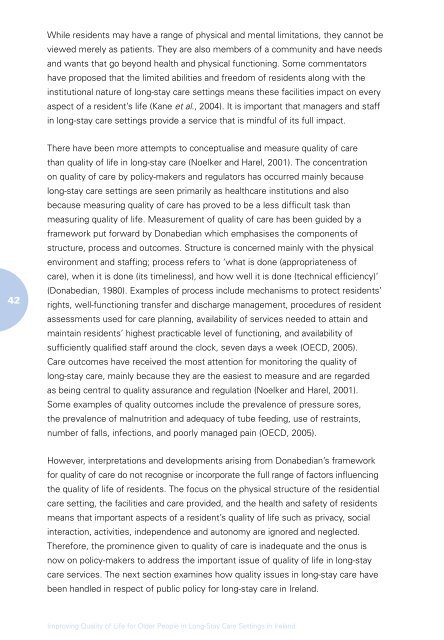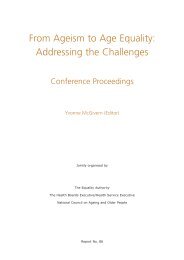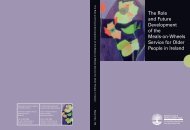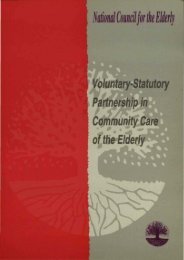Improving Quality of Life for Older People in Long-Stay Care ...
Improving Quality of Life for Older People in Long-Stay Care ...
Improving Quality of Life for Older People in Long-Stay Care ...
- No tags were found...
Create successful ePaper yourself
Turn your PDF publications into a flip-book with our unique Google optimized e-Paper software.
While residents may have a range <strong>of</strong> physical and mental limitations, they cannot beviewed merely as patients. They are also members <strong>of</strong> a community and have needsand wants that go beyond health and physical function<strong>in</strong>g. Some commentatorshave proposed that the limited abilities and freedom <strong>of</strong> residents along with the<strong>in</strong>stitutional nature <strong>of</strong> long-stay care sett<strong>in</strong>gs means these facilities impact on everyaspect <strong>of</strong> a resident’s life (Kane et al., 2004). It is important that managers and staff<strong>in</strong> long-stay care sett<strong>in</strong>gs provide a service that is m<strong>in</strong>dful <strong>of</strong> its full impact.42There have been more attempts to conceptualise and measure quality <strong>of</strong> carethan quality <strong>of</strong> life <strong>in</strong> long-stay care (Noelker and Harel, 2001). The concentrationon quality <strong>of</strong> care by policy-makers and regulators has occurred ma<strong>in</strong>ly becauselong-stay care sett<strong>in</strong>gs are seen primarily as healthcare <strong>in</strong>stitutions and alsobecause measur<strong>in</strong>g quality <strong>of</strong> care has proved to be a less difficult task thanmeasur<strong>in</strong>g quality <strong>of</strong> life. Measurement <strong>of</strong> quality <strong>of</strong> care has been guided by aframework put <strong>for</strong>ward by Donabedian which emphasises the components <strong>of</strong>structure, process and outcomes. Structure is concerned ma<strong>in</strong>ly with the physicalenvironment and staff<strong>in</strong>g; process refers to ‘what is done (appropriateness <strong>of</strong>care), when it is done (its timel<strong>in</strong>ess), and how well it is done (technical efficiency)’(Donabedian, 1980). Examples <strong>of</strong> process <strong>in</strong>clude mechanisms to protect residents’rights, well-function<strong>in</strong>g transfer and discharge management, procedures <strong>of</strong> residentassessments used <strong>for</strong> care plann<strong>in</strong>g, availability <strong>of</strong> services needed to atta<strong>in</strong> andma<strong>in</strong>ta<strong>in</strong> residents’ highest practicable level <strong>of</strong> function<strong>in</strong>g, and availability <strong>of</strong>sufficiently qualified staff around the clock, seven days a week (OECD, 2005).<strong>Care</strong> outcomes have received the most attention <strong>for</strong> monitor<strong>in</strong>g the quality <strong>of</strong>long-stay care, ma<strong>in</strong>ly because they are the easiest to measure and are regardedas be<strong>in</strong>g central to quality assurance and regulation (Noelker and Harel, 2001).Some examples <strong>of</strong> quality outcomes <strong>in</strong>clude the prevalence <strong>of</strong> pressure sores,the prevalence <strong>of</strong> malnutrition and adequacy <strong>of</strong> tube feed<strong>in</strong>g, use <strong>of</strong> restra<strong>in</strong>ts,number <strong>of</strong> falls, <strong>in</strong>fections, and poorly managed pa<strong>in</strong> (OECD, 2005).However, <strong>in</strong>terpretations and developments aris<strong>in</strong>g from Donabedian’s framework<strong>for</strong> quality <strong>of</strong> care do not recognise or <strong>in</strong>corporate the full range <strong>of</strong> factors <strong>in</strong>fluenc<strong>in</strong>gthe quality <strong>of</strong> life <strong>of</strong> residents. The focus on the physical structure <strong>of</strong> the residentialcare sett<strong>in</strong>g, the facilities and care provided, and the health and safety <strong>of</strong> residentsmeans that important aspects <strong>of</strong> a resident’s quality <strong>of</strong> life such as privacy, social<strong>in</strong>teraction, activities, <strong>in</strong>dependence and autonomy are ignored and neglected.There<strong>for</strong>e, the prom<strong>in</strong>ence given to quality <strong>of</strong> care is <strong>in</strong>adequate and the onus isnow on policy-makers to address the important issue <strong>of</strong> quality <strong>of</strong> life <strong>in</strong> long-staycare services. The next section exam<strong>in</strong>es how quality issues <strong>in</strong> long-stay care havebeen handled <strong>in</strong> respect <strong>of</strong> public policy <strong>for</strong> long-stay care <strong>in</strong> Ireland.<strong>Improv<strong>in</strong>g</strong> <strong>Quality</strong> <strong>of</strong> <strong>Life</strong> <strong>for</strong> <strong>Older</strong> <strong>People</strong> <strong>in</strong> <strong>Long</strong>-<strong>Stay</strong> <strong>Care</strong> Sett<strong>in</strong>gs <strong>in</strong> Ireland















